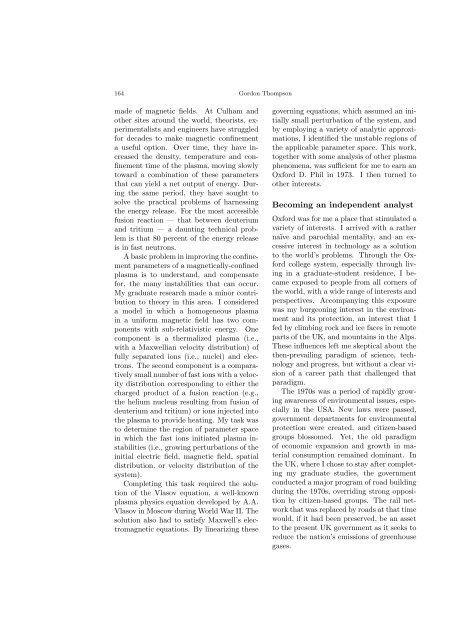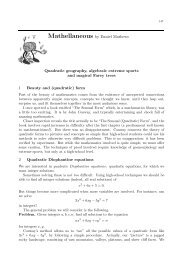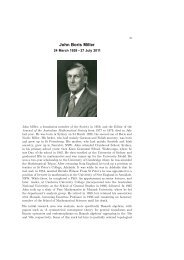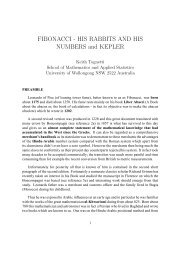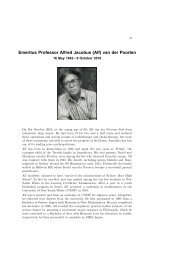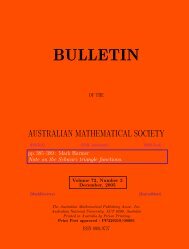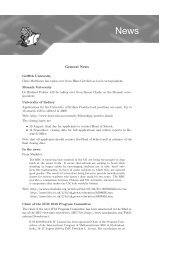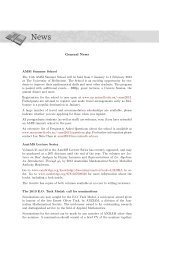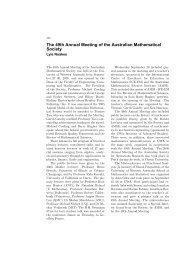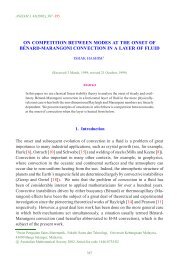Gazette 31 Vol 3 - Australian Mathematical Society
Gazette 31 Vol 3 - Australian Mathematical Society
Gazette 31 Vol 3 - Australian Mathematical Society
Create successful ePaper yourself
Turn your PDF publications into a flip-book with our unique Google optimized e-Paper software.
164 Gordon Thompson<br />
made of magnetic fields. At Culham and<br />
other sites around the world, theorists, experimentalists<br />
and engineers have struggled<br />
for decades to make magnetic confinement<br />
a useful option. Over time, they have increased<br />
the density, temperature and confinement<br />
time of the plasma, moving slowly<br />
toward a combination of these parameters<br />
that can yield a net output of energy. During<br />
the same period, they have sought to<br />
solve the practical problems of harnessing<br />
the energy release. For the most accessible<br />
fusion reaction — that between deuterium<br />
and tritium — a daunting technical problem<br />
is that 80 percent of the energy release<br />
is in fast neutrons.<br />
A basic problem in improving the confinement<br />
parameters of a magnetically-confined<br />
plasma is to understand, and compensate<br />
for, the many instabilities that can occur.<br />
My graduate research made a minor contribution<br />
to theory in this area. I considered<br />
a model in which a homogeneous plasma<br />
in a uniform magnetic field has two components<br />
with sub-relativistic energy. One<br />
component is a thermalized plasma (i.e.,<br />
with a Maxwellian velocity distribution) of<br />
fully separated ions (i.e., nuclei) and electrons.<br />
The second component is a comparatively<br />
small number of fast ions with a velocity<br />
distribution corresponding to either the<br />
charged product of a fusion reaction (e.g.,<br />
the helium nucleus resulting from fusion of<br />
deuterium and tritium) or ions injected into<br />
the plasma to provide heating. My task was<br />
to determine the region of parameter space<br />
in which the fast ions initiated plasma instabilities<br />
(i.e., growing perturbations of the<br />
initial electric field, magnetic field, spatial<br />
distribution, or velocity distribution of the<br />
system).<br />
Completing this task required the solution<br />
of the Vlasov equation, a well-known<br />
plasma physics equation developed by A.A.<br />
Vlasov in Moscow during World War II. The<br />
solution also had to satisfy Maxwell’s electromagnetic<br />
equations. By linearizing these<br />
governing equations, which assumed an initially<br />
small perturbation of the system, and<br />
by employing a variety of analytic approximations,<br />
I identified the unstable regions of<br />
the applicable parameter space. This work,<br />
together with some analysis of other plasma<br />
phenomena, was sufficient for me to earn an<br />
Oxford D. Phil in 1973. I then turned to<br />
other interests.<br />
Becoming an independent analyst<br />
Oxford was for me a place that stimulated a<br />
variety of interests. I arrived with a rather<br />
naïve and parochial mentality, and an excessive<br />
interest in technology as a solution<br />
to the world’s problems. Through the Oxford<br />
college system, especially through living<br />
in a graduate-student residence, I became<br />
exposed to people from all corners of<br />
the world, with a wide range of interests and<br />
perspectives. Accompanying this exposure<br />
was my burgeoning interest in the environment<br />
and its protection, an interest that I<br />
fed by climbing rock and ice faces in remote<br />
parts of the UK, and mountains in the Alps.<br />
These influences left me skeptical about the<br />
then-prevailing paradigm of science, technology<br />
and progress, but without a clear vision<br />
of a career path that challenged that<br />
paradigm.<br />
The 1970s was a period of rapidly growing<br />
awareness of environmental issues, especially<br />
in the USA. New laws were passed,<br />
government departments for environmental<br />
protection were created, and citizen-based<br />
groups blossomed. Yet, the old paradigm<br />
of economic expansion and growth in material<br />
consumption remained dominant. In<br />
the UK, where I chose to stay after completing<br />
my graduate studies, the government<br />
conducted a major program of road building<br />
during the 1970s, overriding strong opposition<br />
by citizen-based groups. The rail network<br />
that was replaced by roads at that time<br />
would, if it had been preserved, be an asset<br />
to the present UK government as it seeks to<br />
reduce the nation’s emissions of greenhouse<br />
gases.


